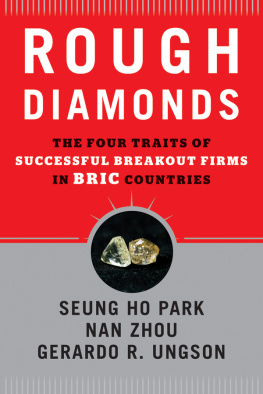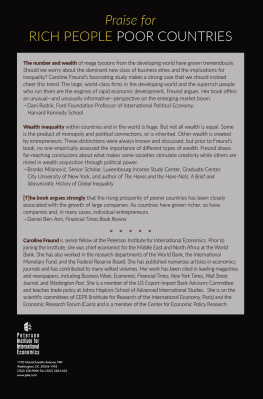
Copyright 2013 by John Wiley & Sons, Inc. All rights reserved.
Cover design by Adrian Morgan
Cover image: Copyright Shutterstock
Published by Jossey-Bass
A Wiley Brand
One Montgomery Street, Suite 1200, San Francisco, CA
94104-4594 www.josseybass.com
No part of this publication may be reproduced, stored in a retrieval system, or transmitted in any form or by any means, electronic, mechanical, photocopying, recording, scanning, or otherwise, except as permitted under Section 107 or 108 of the 1976 United States Copyright Act, without either the prior written permission of the publisher, or authorization through payment of the appropriate per-copy fee to the Copyright Clearance Center, Inc., 222 Rosewood Drive, Danvers, MA 01923, 978-750-8400, fax 978-646-8600, or on the Web at www.copyright.com. Requests to the publisher for permission should be addressed to the Permissions Department, John Wiley & Sons, Inc., 111 River Street, Hoboken, NJ 07030, 201-748-6011, fax 201-748-6008, or online at www.wiley.com/go/permissions.
Limit of Liability/Disclaimer of Warranty: While the publisher and author have used their best efforts in preparing this book, they make no representations or warranties with respect to the accuracy or completeness of the contents of this book and specifically disclaim any implied warranties of merchantability or fitness for a particular purpose. No warranty may be created or extended by sales representatives or written sales materials. The advice and strategies contained herein may not be suitable for your situation. You should consult with a professional where appropriate. Neither the publisher nor author shall be liable for any loss of profit or any other commercial damages, including but not limited to special, incidental, consequential, or other damages. Readers should be aware that Internet Web sites offered as citations and/or sources for further information may have changed or disappeared between the time this was written and when it is read.
Jossey-Bass books and products are available through most bookstores. To contact Jossey-Bass directly call our Customer Care Department within the U.S. at 800-956-7739, outside the U.S. at 317-572-3986, or fax 317-572-4002.
Wiley also publishes its books in a variety of electronic formats and by print-on-demand. Some material included with standard print versions of this book may not be included in e-books or in print-on-demand. If the version of this book that you purchased references media such as CD or DVD that was not included in your purchase, you may download this material at http://booksupport.wiley.com. For more information about Wiley products, visit www.wiley.com.
Library of Congress Cataloging-in-Publication Data
Park, Seung Ho, 1960
Rough diamonds: the four traits of successful breakout firms in BRIC countries / by Seung Ho Park, Nan Zhou, Gerardo R. Ungson. First edition.
Park pages cm
Includes bibliographical references and index.
ISBN 978-1-118-58926-7 (cloth); ISBN 978-1-118-58922-9 (ebk.); ISBN~978-1-118-58951-9 (ebk.); ISBN 978-1-118-58955-7 (ebk.)
1. Industrial managementDeveloping countries. 2. IndustriesDeveloping countries. 3. Industrial policyDeveloping countries. 4. Economic developmentDeveloping countries. I. Zhou, Nan, 1982 II. Ungson, Gerardo R. III. Title.
HD70.D44P37 2013
658.406dc23
2012048752
Foreword
For those few skeptics who still wondered how far-reaching an impact the world's developing markets will have on the global economy, the recent recession provided a pretty compelling answer. Even as the advanced markets in North America and Europe stumbled into recession from 2007 to 2009, and in some cases beyond, emerging markets continued to post significantly higher growth ratescollectively, as much as 5 percentage points higher.
By now, the primary debate about the potential of developing economies has shifted from the discussion of whether they will continue expanding to discussions about how fast they will grow and for how long they can sustain these remarkable rates. The world's top multinationals have already recognized the key role that developing markets will play in their futures. Brazil, Russia, India, and China (BRIC) have become the world's most sought-after markets, drawing new companies and investments with a combination of sizable populations, rising incomes, developing market institutions, and emerging middle classes. For businesses, sustained growth in these BRIC markets is a foregone conclusion, a given that has led many to look for even newer growth markets in Africa, the Middle East, and South America and across much of Asia.
No doubt multinationals from around the world will continue to play a critical role in the ongoing progression of the BRICs and other emerging economies. After all, the countries that have cut themselves off from the global economy and outside investments have seen their economies suffer for it. Yet no national economy can thrive on outside investment alone. Inevitably only the continued rise of domestic companies, reliable market institutions, and a combination of domestic and international trade can sustain the development of these key emerging economies.
The developing BRIC economies can boast a growing roster of home-grown champions that are leading the way. The likes of Tata (India), Gazprom (Russia), Sinopec (China), and Petrobras (Brazil) have long established themselves as globally recognized brands. They challenge even the greatest of multinationals in terms of expertise, innovation, and leadership in their industries. They've set the standard for business in emerging markets. They are the vanguard.
They are not, however, the ticket to broader economic development, at least not on their own. The true power that is fueling genuinely sustainable growth in these markets is coming from the large but often overlooked tier of successful companies and brands that, while not yet household names worldwide, have posted long-term growth rates far higher than those of most of their counterparts in both emerging and developed economies. These companies, including the rough diamonds identified in this book, provide the supporting foundation of domestic growth that necessarily underpins the ongoing development of a broader marketplace and increasingly robust economy in their home countries.
Yet their impact ripples well beyond the people they employ, the products they develop, and the production they contribute to the national and global economies. These companies raise the bar for both public and private entities. Their business demands force governments and regulatory agencies to establish a framework that sustains and enhances development. Their innovation forces staid old companies to raise their game if they want to remain competitive. Their ever-increasing quality raises both the expectations and the capabilities of their customers. And in many cases, their progressive management and world-class leadership vastly improve workplace standards and worker productivity across entire industries.
This sort of fundamental development, if it is to take a solid foothold in emerging economies, must come from within. It has to grow organically, so it can accommodate the idiosyncrasies of each individual countryits history, culture, and political ecosystem. No doubt the global economy has helped establish market institutions and standards of commerce that benefit businesses in any participating nation. Yet within each nation and each domestic market, this tier of long-term growth companies will provide the true foundation for a sustainable economic development.
Perhaps the only guarantee for these emerging economies is that global and domestic forces will arise to challenge their growth. Recessions will occur. Market institutions will stumble. Regulations will fail. And businesses will rise and fall. It's human nature and it's the fundamental nature of human economies. But the stronger the foundation of companies with established business models and long-term growth histories is, the better these developing economies will weather the storms and the more they will thrive in the good times.
Next page







